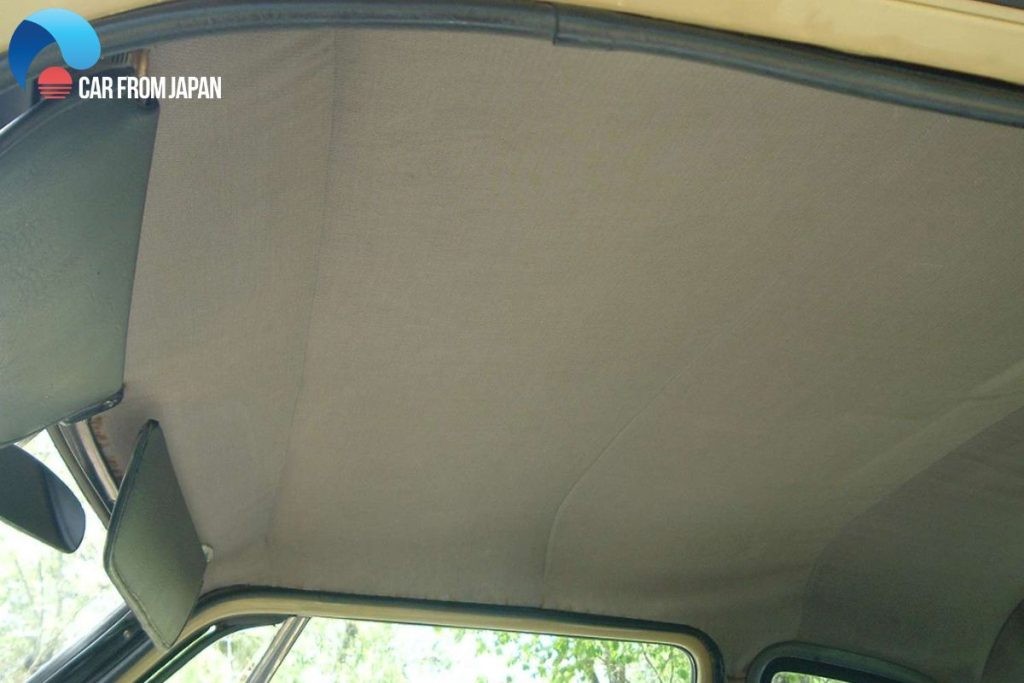A drooping car ceiling, also known as a sagging headliner, is a common issue that can detract from your vehicle’s interior aesthetics and overall comfort. Beyond the unsightly appearance, a sagging headliner can be a nuisance, obstructing your view and even interfering with interior components. The good news is, you don’t always need a costly professional replacement. This guide will explore effective DIY methods to repair your sagging car ceiling without the hassle of complete removal, saving you time and money. Let’s dive in and learn how to restore your car’s interior to its former glory.
Understanding Your Car’s Headliner
Before we get into repairs, it’s essential to understand what a headliner is and its function in your vehicle. The headliner is the fabric material affixed to the inside roof of your car. It’s more than just a cosmetic feature; it plays several crucial roles:
- Aesthetics: It provides a finished, smooth look to the car’s interior, enhancing the overall cabin ambiance.
- Insulation: The headliner offers a layer of insulation, helping to regulate the interior temperature by buffering against external heat and cold. This is crucial for maintaining a comfortable environment inside your car.
- Sound Absorption: It helps to dampen road noise and wind noise, contributing to a quieter and more pleasant driving experience, especially at higher speeds.
- Acoustics: The headliner can also improve the acoustics within the car, enhancing the performance of your car’s audio system.
Typically, a car headliner is constructed from multiple layers. It often includes a foam backing, commonly made of polyurethane, which is bonded to a rigid headliner board. This assembly is then secured to the car’s roof frame.
The car headliner is a crucial component for interior aesthetics, insulation, and sound dampening. (Photo: liveabout.com)
Why Car Headliners Sag: Common Causes
Sagging occurs when the adhesive bonding the fabric to the headliner board deteriorates, causing the fabric to detach and droop. This is a common problem, especially in older vehicles, and several factors contribute to it:
- Heat and Sunlight: Prolonged exposure to intense heat and direct sunlight is a primary culprit. The heat buildup inside a car, especially in the roof area, can weaken and break down the adhesive over time. This is particularly prevalent in regions with hot climates.
- Moisture and Humidity: Moisture, whether from humidity or leaks (such as from a sunroof or windshield), can be absorbed by the foam backing of the headliner. This moisture can degrade the foam and the adhesive, leading to sagging and warping.
- Age and Adhesive Degradation: Over time, even under ideal conditions, the adhesive used in headliners can simply degrade and lose its bonding strength due to age and chemical breakdown.
- Poor Initial Installation: In some cases, a headliner may sag prematurely if it wasn’t installed correctly from the factory or during a previous replacement. Insufficient adhesive or improper installation techniques can lead to early failure.
- Physical Stress: While less common, physical stress from passengers, especially children or pets pulling or scratching at the headliner, can contribute to it coming loose over time.
Understanding these causes can help you take preventative measures and choose the most appropriate repair method.
DIY Methods: How to Repair Sagging Headliner Without Removing It
Replacing the entire headliner can be a significant undertaking, involving removing seats, trim pieces, and potentially even the windshield in some vehicles. Fortunately, there are several effective and budget-friendly methods to repair a sagging car ceiling without going through the complex process of removal. These methods are particularly useful for addressing localized sagging or when you want a quick and cost-effective solution.
Addressing a sagging headliner promptly can prevent further damage and restore your car’s interior appearance. (Photo: liveabout.com)
1. Fabric Adhesive Spray: The Glue-Back-In-Place Method
For minor to moderate sagging, especially around edges or corners, fabric adhesive spray can be a straightforward solution. This method involves re-adhering the fabric to the headliner board using a specialized spray adhesive designed for automotive headliners.
Steps:
- Preparation: Protect your car’s interior by covering seats, trim, and windows with plastic sheeting or painter’s tape to prevent overspray. Clean the sagging headliner area with a soft brush or vacuum to remove any loose debris or dust.
- Apply Adhesive: Using a high-quality automotive headliner adhesive spray, apply an even coat to both the back of the sagging fabric and the corresponding area on the headliner board. Follow the adhesive manufacturer’s instructions regarding spray distance and drying time. Typically, you’ll want to hold the can about 6-8 inches away and apply a light, even coat.
- Reattach Fabric: Allow the adhesive to become tacky (as per the product instructions, usually a few minutes). Carefully press the sagging fabric back into place, working from the center outwards to avoid wrinkles or air bubbles. Use your hands or a soft cloth to smooth the fabric and ensure good contact with the adhesive.
- Curing Time: Allow the adhesive to cure completely, as directed by the manufacturer. This usually takes several hours. Avoid touching or disturbing the repaired area during this time.
Tips:
- Ventilation: Ensure good ventilation when using spray adhesive. Open car doors and windows or work in a well-ventilated area.
- Quality Adhesive: Use a high-temperature resistant adhesive specifically designed for automotive headliners to ensure long-lasting results, especially in hot climates.
- Test in an Inconspicuous Area: Before applying adhesive to a large area, test it in a hidden spot to ensure it doesn’t stain or damage the fabric.
2. Twist Pins: A Quick and Easy Fix
For a fast and inexpensive solution, especially for more significant sagging areas, twist pins (also known as saggy stoppers or clear-headed pins) are a popular choice. These pins are designed to hold the headliner fabric in place without causing significant damage.
Steps:
- Gather Pins: Purchase clear-headed twist pins specifically designed for headliner repair. These are readily available at auto parts stores and online.
- Pin the Sagging Fabric: Gently push the pins through the sagging fabric and into the headliner board behind it. Twist the clear plastic head of the pin to secure it in place.
- Distribute Pins Evenly: Space the pins evenly across the sagging area, starting from the most severely sagging points and working outwards. You can arrange them in a pattern for a more visually appealing result, such as rows or a diamond pattern.
- Check for Secureness: Ensure that the pins are firmly in place and holding the fabric snugly against the headliner board.
Pros:
- Easy to Install: Twist pins are incredibly easy to use and require no special tools or skills.
- Inexpensive: They are a very affordable repair option.
- Quick Solution: The repair can be done in minutes.
Cons:
- Appearance: While clear-headed, the pins are still visible and may not be aesthetically ideal for everyone.
- Not a Permanent Solution: Twist pins are more of a temporary or short-term fix. Over time, the fabric may sag again around the pins.
3. Steam Cleaner and Paint Roller Combo: Re-activating Adhesive
This method utilizes the heat from a steam cleaner to reactivate the original headliner adhesive and a paint roller to smooth the fabric back into place. It works best when the sagging is not too severe and the original adhesive still has some bonding capability left.
Steps:
- Steam Application: Using a handheld steam cleaner with an upholstery attachment, gently apply steam to the sagging headliner area. Keep the steam nozzle moving and avoid concentrating steam in one spot for too long, as excessive heat can damage the fabric. The goal is to warm up the adhesive and make it tacky again.
- Roll and Smooth: Immediately after steaming an area, use a clean, soft paint roller to gently roll over the fabric, pressing it back against the headliner board. Work in sections, steaming and rolling, until the sagging is reduced or eliminated.
- Cooling and Setting: Allow the headliner to cool and dry completely. The reactivated adhesive should re-bond as it cools.
Important Considerations:
- Steam Cleaner Type: Use a handheld steam cleaner designed for upholstery or fabric cleaning. Avoid industrial-strength steam cleaners that produce excessively hot steam, which could damage the headliner.
- Gentle Approach: Be gentle with the steaming and rolling process. Avoid applying too much pressure, which could stretch or damage the fabric.
- Effectiveness Varies: The success of this method depends on the condition of the original adhesive. If the adhesive is completely degraded, this method may not be effective.
4. Headliner Glue in a Syringe: Precision Application
For very localized sagging or areas where you need more precise adhesive application, using headliner glue in a syringe can be beneficial. This allows you to inject adhesive directly behind the sagging fabric without overspray.
Steps:
- Prepare the Syringe: Purchase automotive headliner adhesive and a syringe with a needle or fine tip applicator. Load the syringe with the adhesive.
- Inject Adhesive: Carefully insert the needle or applicator tip behind the sagging fabric, between the fabric and the headliner board. Gently inject a small amount of adhesive.
- Press and Hold: Press the fabric firmly against the headliner board in the area where you injected the adhesive. Hold it in place for a few minutes to allow the adhesive to bond. You can use painter’s tape to hold it in place while it dries.
- Repeat as Needed: Repeat the injection and pressing process for other sagging areas as needed.
Advantages:
- Precise Application: Allows for very targeted adhesive application, minimizing mess and overspray.
- Good for Small Areas: Ideal for repairing small, isolated sagging spots or edges.
Disadvantages:
- More Time-Consuming: This method can be more time-consuming than spray adhesive for larger areas.
- Requires Dexterity: Requires some dexterity to inject the adhesive accurately.
Preventing Sagging Headliners: Proactive Measures
While repair methods are helpful, preventing sagging in the first place is always better. Here are some preventative tips to extend the life of your car’s headliner:
- Park in the Shade: Whenever possible, park your car in shaded areas or garages, especially during hot and sunny weather. This reduces heat buildup inside the car and minimizes adhesive degradation.
- Use Sunshades: Utilize windshield sunshades and window shades when parking in direct sunlight to further reduce interior heat.
- Ventilate Your Car: On hot days, crack your windows slightly (if safe to do so) to allow for ventilation and reduce heat buildup.
- Address Leaks Promptly: Repair any leaks in your sunroof, windshield seals, or door seals immediately to prevent moisture from damaging the headliner.
- Gentle Interior Cleaning: When cleaning your car’s interior, avoid using excessive moisture or harsh chemicals on the headliner. Use a soft brush or vacuum with a soft brush attachment for cleaning.
- Limit Physical Stress: Discourage children and pets from pulling or scratching at the headliner.
When to Consider Professional Headliner Replacement
While DIY methods are effective for many sagging headliner issues, there are situations where professional replacement may be the best or only option:
- Extensive Sagging: If the headliner is sagging severely throughout the entire roof area, DIY repairs may be less effective and more time-consuming than a professional replacement.
- Damaged Headliner Board: If the headliner board itself is warped, cracked, or damaged, simply re-adhering the fabric may not solve the problem. Replacement of the entire headliner assembly might be necessary.
- Desire for a Perfect Finish: While DIY repairs can improve the appearance of a sagging headliner, they may not always achieve a factory-perfect finish. If you desire a flawless result, professional replacement is recommended.
- Lack of DIY Confidence: If you are not comfortable with DIY car repairs or lack the time or tools, professional headliner replacement is a convenient option.
Cost of Professional Headliner Replacement:
The cost to replace a car headliner professionally can vary depending on the vehicle make and model, the complexity of the headliner design, and labor rates in your area. Generally, you can expect to pay anywhere from $300 to $1000 or more. Luxury vehicles or those with complex headliner designs (e.g., with sunroofs, integrated lighting, or intricate shapes) will typically be on the higher end of the cost spectrum.
Here’s a general cost range breakdown:
- Sedans/Hatchbacks/Coupes (Simple Design): $300 – $750
- SUVs/Crossovers (Sunroof/Moonroof): $500 – $900
- Luxury Vehicles (Complex Design/High-Quality Materials): $1000 – $6000+
Consult with local auto upholstery shops or mechanics for accurate quotes specific to your vehicle.
Conclusion
A sagging car ceiling is an annoying but often manageable problem. By understanding the causes and utilizing the DIY repair methods outlined in this guide, you can effectively restore your car’s interior appearance and comfort without the need for expensive professional replacement in many cases. Whether you choose the simplicity of twist pins, the targeted approach of adhesive syringes, or the reactivating power of steam, taking action to repair your sagging headliner will enhance your driving experience and maintain your vehicle’s value. For severe cases or if you prefer a guaranteed perfect finish, professional headliner replacement remains a viable option.
FAQs About Sagging Car Ceilings
How do I know if my car ceiling is sagging?
Signs of a sagging car ceiling include:
- Visible drooping fabric that is detached from the roof.
- Bubbling or wrinkling of the headliner material.
- Fabric that is loose and may touch your head or obstruct your vision.
- In severe cases, the headliner may partially detach and hang down.
Is it okay to fix a sagging headliner myself?
Yes, for many cases of sagging headliners, DIY repair is perfectly acceptable and can save you significant money compared to professional replacement. The methods described in this guide are designed for DIYers and are effective for addressing common sagging issues.
Can I paint a car headliner?
While technically possible, painting a car headliner is generally not recommended. Paint can make the fabric stiff, potentially alter its sound-absorbing properties, and may not adhere well long-term due to temperature fluctuations inside the car. Repairing or replacing the headliner fabric is usually a better approach.
Will car insurance cover headliner replacement?
Typically, standard car insurance policies do not cover headliner replacement due to wear and tear or cosmetic issues. Headliner damage is usually considered a maintenance issue, not a covered loss event like an accident or natural disaster. However, it’s always best to review your specific insurance policy for details on coverage.



